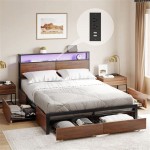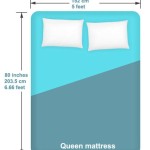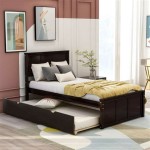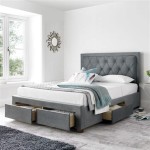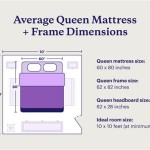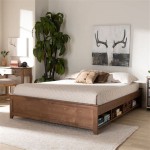What Size Box Spring for a King Bed: A Comprehensive Guide
Selecting the correct box spring for a king-size bed is crucial for ensuring proper mattress support, comfort, and longevity. A mismatched box spring can compromise the structural integrity of the bed and even void mattress warranties. This article provides a detailed overview of the dimensions, types, and considerations involved in choosing the right box spring for a king-size bed.
A box spring, traditionally consisting of a wooden or metal frame containing springs, provides foundational support for a mattress. While modern variations exist, the primary function remains the same: to elevate the mattress, absorb shock, and distribute weight evenly. Understanding the different types and dimensions of box springs is essential for making an informed decision that best suits individual needs and preferences.
Standard King Box Spring Dimensions and Configurations
The standard dimensions of a king-size bed are 76 inches wide and 80 inches long. Consequently, the box spring must match these dimensions to provide adequate support. However, there are different configurations to consider: a single king box spring or two twin XL box springs.
A single king box spring measures the full 76 inches by 80 inches. This option provides seamless support across the entire mattress. However, its size can make it difficult to maneuver through doorways and hallways, particularly in older homes with narrower passages. Delivery and setup can also present logistical challenges.
Alternatively, using two twin XL box springs is a common and often more practical approach. A twin XL box spring measures 38 inches wide and 80 inches long. When placed side-by-side, two twin XL box springs provide the same overall support area as a single king box spring (76 inches x 80 inches). This configuration offers several advantages, including easier transportation, handling, and installation. The modular design simplifies navigating tight spaces and reduces the risk of damage during delivery. Furthermore, if one box spring requires replacement, only one half of the support system needs to be addressed, potentially saving costs.
Regardless of whether you opt for a single king box spring or two twin XLs, it is crucial to ensure that the combined dimensions perfectly match the dimensions of the king-size mattress. Discrepancies can lead to uneven weight distribution and premature wear on the mattress.
Box Spring Height Considerations
Beyond the length and width, the height of the box spring is another critical factor to consider. Box springs are typically available in three standard height profiles: standard, low profile, and ultra-low profile. Each height offers distinct aesthetic and functional benefits.
A standard box spring height usually ranges from 8 to 9 inches. This height provides ample support and creates a significant elevation for the mattress. This option is suitable for individuals who prefer a higher bed and find it easier to get in and out of bed with increased height. However, if the bed frame is already tall or the mattress is particularly thick, a standard-height box spring might result in an excessively high bed, which can be aesthetically unappealing or even uncomfortable for some users.
Low-profile box springs typically measure between 5 and 6 inches in height. This option offers a more contemporary and streamlined look. It is particularly well-suited for thicker mattresses or bed frames with built-in height. A low-profile box spring maintains proper mattress support while minimizing the overall height of the bed, creating a more balanced and visually pleasing aesthetic. It can also be a practical choice for individuals who prefer a lower bed height or have mobility concerns.
Ultra-low-profile box springs, sometimes referred to as slim or thin box springs, are generally 2 to 4 inches in height. These are often used primarily to offer a flat, supportive surface for the mattress, rather than adding significant height. They are often employed with platform beds or when a very minimalist aesthetic is desired. While offering minimal height, it is essential to ensure that they still provide adequate support for the specific mattress type being used.
The selection of box spring height is largely dependent on personal preference, the height of your bed frame, and the thickness of your mattress. It is generally advisable to measure the existing bed frame and mattress height to determine the optimal box spring height that will achieve the desired overall bed height and aesthetic.
Alternative Support Options: Platform Beds and Adjustable Bases
While box springs have been the traditional mattress support system, alternative options such as platform beds and adjustable bases have gained considerable popularity. These options offer distinct advantages and may eliminate the need for a traditional box spring.
Platform beds feature a solid or slatted surface that provides direct support to the mattress. The platform eliminates the need for a box spring, creating a lower profile and streamlined aesthetic. Platform beds are available in various styles and materials, making them a versatile choice for different bedroom decor themes. They also offer the advantage of increased under-bed storage space in some models. If opting for a platform bed, it is crucial to ensure that the platform's surface is sufficiently sturdy and provides adequate support for the mattress weight and the sleepers. The spacing between slats should be appropriate to prevent mattress sagging or damage.
Adjustable bases offer unparalleled comfort and adjustability. These bases allow users to elevate the head and/or foot of the bed, providing customized sleeping positions. Adjustable bases are particularly beneficial for individuals with medical conditions such as acid reflux, sleep apnea, or back pain. While some adjustable bases are designed to replace a traditional box spring, others are compatible with existing bed frames. When considering an adjustable base, it is essential to verify its compatibility with the mattress. Some mattresses, particularly innerspring models with encased coils, may not be suitable for use with adjustable bases. Latex and memory foam mattresses are generally recommended for optimal performance and flexibility.
The decision to use a traditional box spring, a platform bed, or an adjustable base depends on individual needs, preferences, and budget. Platform beds offer a cost-effective and stylish alternative to box springs, while adjustable bases provide enhanced comfort and functionality. Before making a decision, it is advisable to research the different options and consider the specific requirements of your mattress and sleeping habits.
Beyond the structural aspects, consider the material and construction quality of the box spring. A well-constructed box spring will typically feature a sturdy frame made of wood or metal, covered with a durable fabric. Look for box springs with reinforced corners and center support bars to ensure maximum stability and longevity. The fabric covering should be breathable and resistant to wear and tear. Some box springs may also incorporate features such as non-slip surfaces to prevent mattress movement.
Furthermore, warranty coverage is an important consideration when selecting a box spring. A reputable manufacturer will typically offer a warranty that covers defects in materials and workmanship. Review the warranty terms and conditions carefully to understand the coverage period and any limitations or exclusions. A longer warranty period generally indicates a higher level of confidence in the product's durability and quality.
Before purchasing a box spring, it is always advisable to consult the mattress manufacturer's guidelines. Some mattress warranties may require the use of a specific type or brand of box spring to maintain the warranty coverage. Failure to comply with these requirements could potentially void the warranty in case of mattress damage or premature wear. Pay close attention to any recommendations or requirements outlined in the mattress warranty documentation.
Ultimately, selecting the appropriate box spring for a king-size bed involves careful consideration of dimensions, height, support needs, and budget. By understanding the different options available and prioritizing quality and compatibility, individuals can ensure optimal mattress support, comfort, and longevity, contributing to a restful and rejuvenating sleep experience.

Mattress Foundation Sizes And Dimensions Guide Amerisleep

Box Spring Sizes Every Size And Types Of Springs

2 Box Spring

Homzene 9 In King Size Box Spring With Metal Structure Mattress Foundation Frabric Cover Easy Assembly And No Squeak Thd Sbs05

Mainstays 7 5 Half Fold Metal Box Spring King

Continental Sleep 8 California King High Profile Wood Box Spring For Mattress White

Box Spring Sizes Every Size And Types Of Springs

Homzene 9 In King Size Box Spring With Metal Structure Mattress Foundation Frabric Cover Easy Assembly And No Squeak Thd Sbs05 The Home

King Box Springs At Com

What Size Box Spring For King Bed Arlene S Home

